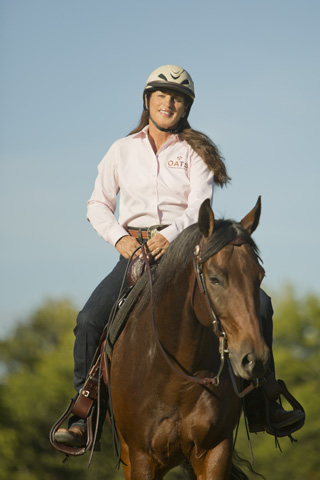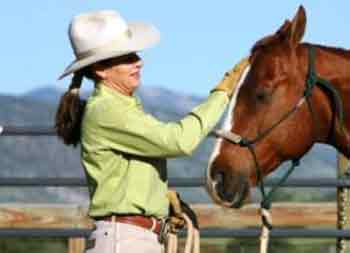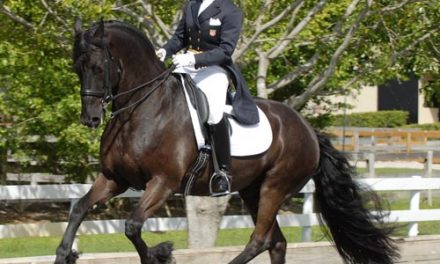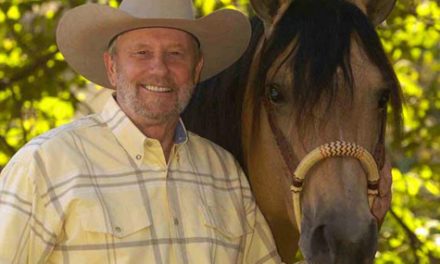Notes From Julie
 Most things in life that are important, take an investment of time—an education, a career, a relationship. Mastering a skill or a sport, starting a new business, overcoming setbacks; none of this comes quickly. Horses are not the best sport for instant gratification. It takes time to set your goal then to work diligently to identify all the steps necessary to work up to the bigger dream. Whether you’re working on a riding goal or to condition your horse, one thing’s for sure: it takes time.
Most things in life that are important, take an investment of time—an education, a career, a relationship. Mastering a skill or a sport, starting a new business, overcoming setbacks; none of this comes quickly. Horses are not the best sport for instant gratification. It takes time to set your goal then to work diligently to identify all the steps necessary to work up to the bigger dream. Whether you’re working on a riding goal or to condition your horse, one thing’s for sure: it takes time.
With horses, after about 30 days of daily work, you start seeing physical changes in the horse’s fitness level—a flatter underline, more muscle definition, more energy. After 90 days, your horse is looking pretty fit and after 120 days your horse is ripped like a body builder.
Thirty-day increments of training are standard in the horse industry, whether we are talking about fitness levels, the time needed for the horse to perfect skills or for the cost of training. Many trainers, myself included, would say that 90-days is minimum to accomplish much of anything with a horse and we are talking about years of training for the truly finished horse.
Our society’s fast-paced, on-demand culture seems to sprinkle over into horse training. We want it all fast and right away. I hear this need-for-speed from riders, too. When looking through the applications for my TV show, Horse Master, I often see riders who want to work on flying lead changes. However, the horse they are riding is young or they themselves haven’t mastered the canter departure yet. Many skills precede flying lead changes—like haunches–in, leg-yielding, head-to-tail body control, halt-to-canter departures, counter-canter, then master the simple lead change, then learn the principles of the horse’s movements and how to cue for a change on the fly.
We want the end result—the pretty, finished picture—and we want it now. But to honor the horse, we must allow time and we must break down our lofty goals into smaller, attainable, slow steps.
Breaking down the training process
When my young horse Eddie, was very green, we struggled with leads at the canter. He always seemed to over-think it and he second guessed himself a lot (pick up the correct lead, switch to the wrong, then switch back—all in three strides). He got tense and hollow whenever it was time for a canter transition and needed some extra time to understand. I started breaking things down more and more, working more on haunches-in at walk and trot, sequencing my cues more clearly, giving lots of pre-signal and setting him up very definitively for the correct lead.
Fortunately, I had no deadline or reason to rush through his training; I just asked for a little more each day. For months, I only asked for one departure on each lead a day, and by taking the time he needed and preparing him as best I could, he became very solid on his leads and his walk to canter transitions were great by the time he was four.
Whatever time it takes, is what it takes for a horse to learn something and while Eddie eventually did learn flying lead changes, none of it came easy—especially the next step. Once Eddie and I had a clear understanding of which lead I was asking for and he was batting a thousand with his leads, I thought it was a good time to introduce the counter-canter (going intentionally on the wrong lead)—a very important obedience and cueing exercise in preparation for lead changes. It blew his mind so badly he thought surely the world was ending. It was almost comical how wrong Eddie thought the counter-canter was and once again, it took a long time to convince him otherwise. Months, not hours.
Allowing recovery time
Healing takes time too. Lots of it and usually more than you think. Whether it’s from an injury or illness to you or your horse, or from a broken heart or a tragic loss; healing takes time and it should not be rushed. I’ve known of many horses that have been able to make big comebacks from terrible injuries or sickness, because their owners were willing to invest time and resources and have waited patiently for adequate healing to occur. Sadly, I have known many more horses that have been rushed back into training and performance, with predictable and disappointing results.
When my horse, Dually, torqued his back, I called in all the possible help. He had chiropractic treatments, acupuncture, a full veterinary exam, pharmaceuticals and nutra-ceuticals, physical therapy, and I doubled the healing time that was recommended. I wanted to make sure he was ready to return to work before asking him to perform. This was not as easy task as this is a horse who wants to work! He hated when I would walk into the pen and halter Eddie instead of him. When he did return to work, he was ready to go even though I knew I wanted to have a safe and steady plan for his re-entry to arena and performance work.
When it was time for him to return to exercise, I started by turning him loose in the arena and watching closely as he moved around voluntarily. Dually is never shy about letting you know if he hurts. Good results there, so I started ponying him from my other horse and just letting him walk it out. After a few days we added the trot; after a week or so, we started longeing over ground poles and backing him up in-hand, to get him to stretch and lift his back. After a few weeks, as Dually got stronger, he also got more confidant and energetic and soon I started riding again—but bareback. I spent four months riding bareback, to be easier on his back and so I would not stop and turn as hard. All told, it was about a year and a half before we were back to pre-injury levels.
Anyone who has ever suffered an injury from riding or handling horses already knows that well beyond the physical healing, it also takes time to rebuild confidence when it’s been lost. Whether we are talking human flesh or horse flesh, confidence can be lost in an instant, but takes a long time to rebuild. The same thing could be said of trust; it takes time to build it but you can lose it in a heartbeat. Trusting a horse, the horse trusting you, trusting that you can not only survive the situation, but control it—these things take time to reconstruct.
It has been said many times, when it comes to horses (and life), patience is a virtue. Having realistic long-term goals, slow and steady plans to get you there, investing the time, being patient, not afraid of failure and committed to the outcome, will almost certainly insure your success—both in life and with horses.
Julie Goodnight
Julie Goodnight takes on topics you want to know more about in her online training library—part of her ever-expanding Horse Master Academy (http://signin.juliegoodnight.com) now with a free access membership to help you search for many training articles, videos and MP3s!
For more thoughts from Julie, watch her Horse Master TV show each Monday night on RFD-TV (at 2 and 10 pm ET on RFD-TV!) or catch the show online anytime at TV.JulieGoodnight.com and please subscribe to the free Youtube channel at http://youtube.com/juliegoodnight and find her on Instagram.





